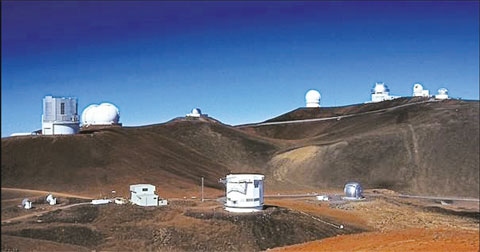 Mauna
Kea observatories
You may have heard of a volcano in the island of Hawaii which is said
to be actually higher than the famed Mount Everest when measured from
the ocean bed.
The peak of this volcano standing at 13,803 ft (4,207 m) above sea
level, is the highest point in the U.S. state of Hawaii. However, much
of the mountain is below sea level. So, when it is measured from its
oceanic base, the total height difference is 33,500 ft (10,200 m),
significantly taller than the elevation of Mount Everest (8,848 m/29,029
ft).

Mauna Kea is about two million years old, and has passed the most
active shield stage of life hundreds of thousands of years ago.. Mauna
Kea last erupted 4,600 years ago. According to the USGS, as of January
2012, the Volcanic-Alert Level is "Normal".
With its high altitude, dry environment, and stable airflow, Mauna
Kea's summit is one of the best sites in the world for astronomical
observation, and one of the most controversial. Since the creation of an
access road in 1964, 13 telescopes funded by eleven countries have been
constructed at the summit.
The Mauna Kea Observatories (MKO) are used for scientific research
across the electromagnetic spectrum from visible light to radio, and
comprise one of the world's largest facilities of their type. The
independent collection of astronomical research facilities on the summit
are located in a 500-acre special land zone known as the "Astronomy
Precinct", in the Mauna Kea Science Reserve.The University of Hawaii
manages the site and leases land to several multinational facilities .
The altitude and isolation in the middle of the Pacific Ocean makes
Mauna Kea one of the best locations on Earth for ground-based astronomy.
It is an ideal location for submillimeter, infrared and optical
observations.
Telescopes found at the summit of Mauna Kea are funded by government
agencies of various nations.
The University of Hawaii itself directly administers two telescopes.
In total there are 12 telescopes in or around the summit of Mauna Kea. |



